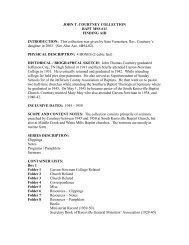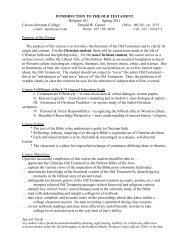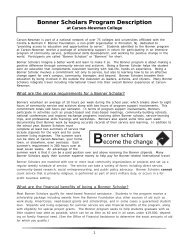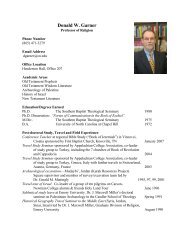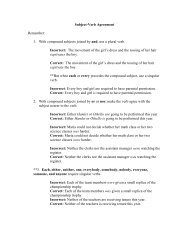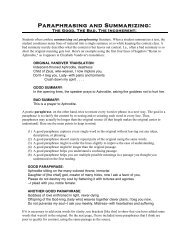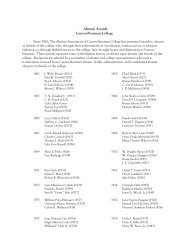a comparative analysis of louis durey and francis poulenc's settings ...
a comparative analysis of louis durey and francis poulenc's settings ...
a comparative analysis of louis durey and francis poulenc's settings ...
Create successful ePaper yourself
Turn your PDF publications into a flip-book with our unique Google optimized e-Paper software.
44<br />
Le Dauphin—Durey<br />
The accompaniment in “Le Dauphin,” with the right h<strong>and</strong> only, is thin, but<br />
effectively conveys the sparkling brilliance <strong>of</strong> the dolphin <strong>and</strong> its glimmering waters.<br />
Like Durey’s “Le Chèvre du Thibet” <strong>and</strong> “La Sauterelle,” the majority <strong>of</strong> the piece is<br />
played in the treble clef. The six-note arpeggiated figure throughout the piece has a<br />
smooth harp-like feel. It begins based upon the pentatonic scale, D E F# A <strong>and</strong> B,<br />
undergoes a series <strong>of</strong> tonality shifts, starting at measure four, <strong>and</strong> gradually descends an<br />
octave in measure 18, before slowing slightly <strong>and</strong> returning to the premier figure in<br />
measure 20.<br />
Fig. 8 “Le Dauphin,” mm. 1-2<br />
The tempo marking tranquille is especially suitable for the calm, ethereal feel <strong>of</strong><br />
this piece. The sustaining pedal adds to the feeling <strong>of</strong> the smooth flow <strong>of</strong> the tide <strong>and</strong> aids<br />
in maintaining a seamless consistency in the accompaniment from measure to measure.<br />
There is an inconsistent number <strong>of</strong> measures between vocal phrases, which makes the<br />
piece sound conversational <strong>and</strong> spontaneous, to an extent.<br />
At the mention <strong>of</strong> joy in measures 15-17, the vocal line crescendos <strong>and</strong> the line<br />
ascends to an E, the highest note in the piece. In the following line, the voice ascends to a<br />
D on the word cruelle (cruel), which perhaps indicates that although the poet’s (<strong>and</strong><br />
dauphin’s) existence is cruel, the joy far outweighs the cruelty.



